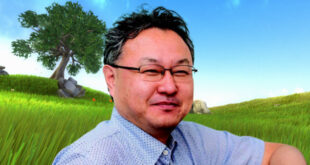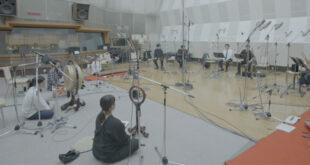My journey began a little over a year ago when I left my position as A.I. lead at Retro Studios in Austin, Texas to return home to the UK.
Although my original intention had been to go to the States for just a year or two, ten years later the inescapable truth was that I had become very settled in Austin. The combination of high-tech yet slightly off-beat culture, warm desert air, fantastic food, low taxes and relaxed lifestyle made it an easy place to be.
I had sixteen years experience in the industry and with a number of high profile Nintendo titles on my C.V., things were going well. I loved working with the team at Retro and I especially enjoyed the opportunity to learn from Nintendo’s Software Planning and Development Group. SPD was a small team led by Kensuke Tanabe who worked tirelessly with us to help refine our work and stay in alignment with the Nintendo way. I valued their input tremendously and felt very grateful for the different perspective they brought to the table.
Sadly, however, the time had come for me to choose where to settle for the long term. It was an agonising, soul-searching process but eventually the decision was made and there was no turning back; it was time to go home.
Just when I thought I was out
Arriving back in the U.K. I faced something of an income problem. Having made the decision to live in my native Wales, employment options for veteran game developers were limited. I briefly considered changing careers but quickly dismissed the idea as madness. There were too many games to be made! Instead, I interpreted the moment as my chance to step-up to the plate and put my experience to the test.
It was an agonising, soul-searching process but eventually the decision was made and there was no turning back; it was time to go home.
Forming Squarehead Studios, I knew that I didn’t want to jump straight in and try to make my magnum opus. Instead, I wanted to launch with a project that kept the quality bar high but was pragmatic in scope.
Around this time, I got my hands on an iPad Air and was immediately sold on its gaming potential. It seemed like the ideal platform for the kind of project I had in mind and so I cranked the dials to eleven and got to work, only to lift my head five months later with the realisation that I had just completely wasted my time.
If at first you don’t succeed
I had developed a prototype to a fairly advanced state, and by many standards it was looking good. It built on my prior experience developing successful platform games, it was unique, it had a ton of personality and it was fun to play. Sadly, I realised that it was also going to require an art team well beyond my budget to complete. If making mistakes is the way that we learn best, I suppose I should be grateful for my education!
You might be wondering why I didn’t go to a publisher or launch a Kickstarter campaign and raise the funds to see it through. The truth is that I didn’t want to let go of control so early in the process and I also didn’t want to risk Squarehead’s first project blowing up into a three year development cycle.
More philosophically, I wanted to grow Squarehead at a very controlled pace. When the company expands, I want it to be slow and careful, very much with a long term view. Investing in people is a core value of mine and hiring the right people takes time. I want to make sure that those who come onboard will feel secure in their employment, safe in the knowledge that we are on a sound financial footing.
You might be wondering why I didn’t launch a Kickstarter campaign. The truth is I didn’t want to risk Squarehead’s first project blowing up into a three year development cycle.
So with these points in mind I made the difficult decision to shelve the project until a later date. It was a tough time. I had to accept that I’d made a big mistake on my very first attempt. I was annoyed with myself and I expected people would begin to raise eyebrows. It felt like a bit of a mess.
After the tears had dried, I picked myself up and told myself not to panic. I knew that the prototype was good and technically at least there would be no problem moving forward. I just had to trust myself and get on with a project of slightly humbler scope.
In the days and weeks that followed, the temptation to rush straight into the next project was immense. It took a lot of discipline but I managed to resist and formulated a plan to make four different prototypes from my "long list of games that I would really like to make someday".
Two prototypes later, my self-control was in tatters.
Emotional rollercoaster
The first prototype had gone well and featured some promising elements but when I made the second – a procedurally generated, one-button shoot-em-up – I knew in an instant that I wouldn’t be able to resist moving straight into production with it.
I have a passion for arcade classics and an equally strong dislike of virtual joysticks. Having developed the rocket-barrel and the mine-cart for Donkey Kong Country Returns, I knew that the one-button control scheme was a perfect fit for a modern shmup. The scope of the project was ideal too; I could reasonably expect to finish it with a high degree of polish and even tackle the relatively simple art requirements myself. The decision was made.
With the basic controls in place, it took another couple of weeks to implement the procedural generation system and to refine the codebase to handle full production. At this stage the graphics consisted of simple geometric shapes but the core functionality was all there and most importantly, it was fun to play. With the first ninety percent done, it was time to focus on the other ninety percent!
The next nine months or so consisted of fleshing out the enemy A.I.s, devising the power-up system, insane amounts of graphical iteration, finding sound effects and way too much time spent play testing; I would often sit down to check one new addition or bug fix, only to find myself still playing an hour later.
It took a lot of discipline but I managed to resist and formulated a plan to make four different prototypes from my ‘long list of games that I would really like to make someday’. Two prototypes later, my self-control was in tatters.
Along the way I was riding an emotional roller coaster. There were days of intense doubt, where I had to take a step back and remind myself that it was normal to feel a loss of confidence during development. I told myself to ignore the negative voices, work the process and trust in my abilities. I knew that there was a strong correlation between my level of tiredness and my negative feelings towards the project. This awareness helped to dismiss the demons and served as a helpful reminder to get a proper night’s rest.
The final piece of the development puzzle fell into place when David Wise agreed to compose the soundtrack. Dave is an industry legend and to have his support meant a great deal to me. We figured out the brief together and then Dave went away and just completely nailed it. Unfortunately, I suffer from a condition where I have high expectations in areas for which I have a complete lack of talent. I needn’t have worried, Dave’s work far exceeded my feeble musical imagination and I was delighted with the atmosphere it brought to the game.
Some people might look at Star Drift and jump to the conclusion that it is a Geometry Wars clone, or they might hear about the control mechanics and assume that it’s inspired by Flappy Bird. Not so – working at Nintendo taught me to ignore the rest of the industry and all the noise floating about; instead just think about your own game and what you want it to be.
The end of the beginning
I created Star Drift knowing that the odds of success were very, very small. The challenge of going indie and producing a game on your own is not for the faint-hearted. In addition to the development journey described here – there are many other factors to consider, ranging from the deceptively simple things like naming your studio and your game to the time-consuming monsters like handling press relations, marketing, navigating the platform approval processes, quality assurance, legal and accounting issues, dealing with business opportunities and setting out your long term strategy. Be prepared for your organisational skills, nerves and self-belief to be tested to the limit and quite possibly beyond.
Working at Nintendo taught me to ignore the rest of the industry and all the noise floating about; instead just think about your own game and what you want it to be.
Is it worth it? Absolutely. As a game developer, you will never feel as whole as you do when you have full control. Working for yourself ties your life together into one seamless experience that finally makes perfect sense. You will be excited to get out of bed each and every day and you will be forced to grow and discover more about yourself and what you’re truly capable of.
This first chapter for Squarehead Studios has been an exhilarating journey. Early indications are that Star Drift is resonating well with its intended audience. I’m confident that it’s a game I’ll be returning to over the years and I derive satisfaction from having made a game that I really enjoy playing myself.
In the coming months, there are ports to be taken care of and the careful process of expanding the studio. Hopefully the team might grow a little but the principle of making games that we want to play ourselves will stay resolutely the same.
You can visit www.squareheadstudios.co.uk or follow along on Twitter @SquareheadStdio to see how things turn out. It might be a bit bumpy but I would love to have you along for the ride.
Got a story to tell? Want to share your development experience with new and aspiring game-makers? Email Craig via cchapple@nbmedia.com to find out how you can get involved.

 MCV/DEVELOP News, events, research and jobs from the games industry
MCV/DEVELOP News, events, research and jobs from the games industry



